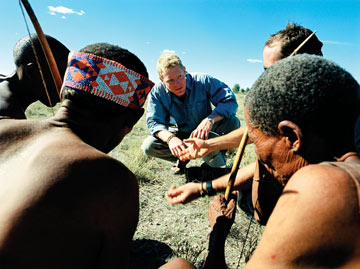|
DOWN TO EARTH WITH...: News about people from AGI and its 44 member societies
Archive of past profiles stories by date
Spencer Wells
More on the Genographic Project
 The Genographic Project |
| Population geneticist Spencer Wells has gathered genetic information from indigenous people around the world to track ancient human migration. |
National Geographic Explorer-in-Residence, documentary filmmaker and population geneticist Spencer Wells has spent more than a decade on the trail of Adam — or rather, on the trail of a genetic marker that exists only on the Y chromosome and can be tracked back in time to a single man who lived in Africa about 60,000 years ago. Since 1996, Wells has collected DNA samples from indigenous populations in Central Asia, the former Soviet republics and elsewhere around the globe, seeking to trace the migration of human ancestors.
That work has ultimately led to the “Genographic Project,” an ongoing, five-year effort directed by Wells and sponsored by National Geographic and other organizations to track ancient human migration across the globe using tens of thousands of DNA samples from indigenous and traditional populations around the world, as well as from thousands of non-indigenous volunteers. Launched in April 2005, this global database, Wells says, reveals not only human genetic diversity, but also how closely related we ultimately are.
Wells has also brought his discoveries back to the public with the book and subsequent PBS documentary The Journey of Man: A Genetic Odyssey, which followed his DNA-collecting expeditions around the world during 2001 and 2002. He recently published a second book, Deep Ancestry: Inside the Genographic Project. He spoke with Geotimes reporter Carolyn Gramling about his work.
CG: How did you become interested in investigating this genetic detective story?
SW: Initially, I was interested in history — the science came later. I’m fascinated by the past, by the notion that [with genetics] you can travel back in time. When I studied science, I wanted to integrate that into a way of looking at the past, and the branch of biology that has relevance to history is genetics.
CG: What part of a person’s DNA do you use to track their ancestors?
SW: What we study are genetic markers, tiny changes in the genetic sequence. They don’t occur often — out of 6 billion letters in the sequence, just 50 per genome per generation [change]. Those changes then get passed on to descendents as stable markers, and can be used to “tag” a lineage back to the person who first had that change in DNA. Ultimately, we can connect everybody in the world — like branches of a tree, which get back to a root. And that root turns out to be Africa.
In Deep Ancestry, we explain how we trace ancestry using mitochondrial DNA [which is passed only through the female line], as well as the markers on the Y chromosome.
CG: Why did you decide to make a book and documentary film of your travels?
SW: That wasn’t something I set out to do. I was a straightforward academic, running research, and they came out of work I had been doing for the previous five years. But as we published these papers, we realized they can be understandable to a wider audience. This is something that people can identify with — you talk about Genghis Khan’s lineage and suddenly peoples’ eyes light up.
And we’re continuing to make documentaries about using genetics on mummies or people who look like Norwegian Vikings to explain human diversity and the meaninglessness of race.
CG: What does your latest book, Deep Ancestry, cover?
SW: It explains the science and describes the launch of the Genographic Project. It runs the gamut from very deep ancestry — between 200,000 years ago and 50,000 to 60,000 years ago — to recent events, such as the impacts of the Crusades on the genetic landscape of the Middle East. It goes from technical issues to these very deep questions about origins.
CG: In addition to indigenous people, you have volunteers from all over the world sending in DNA samples so their own deep ancestry can be tracked. Why are people so eager to learn about their ancestors from long ago?
SW: Well, there are people who are very interested in the science, and want to be part of a real-time scientific effort, which doesn’t happen very often. And there are people who come at it from a genealogical angle, which is very popular in North America. There are a lot of participants from North America — we’re a [continent] of immigrants here. We have a vague notion of being a “hyphenated” American, but we don’t have a strong sense of connection to where our ancestors lived.
More on the Genographic Project:
"Tracing Human Migration," Geotimes, September 2005
Genographic Project

 Subscribe
Subscribe


